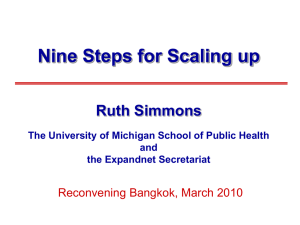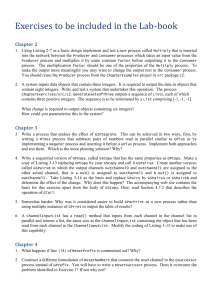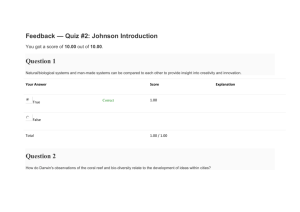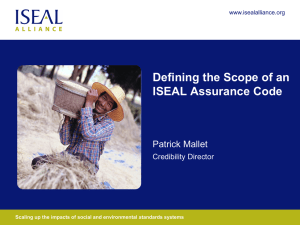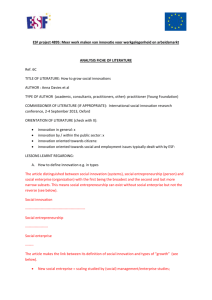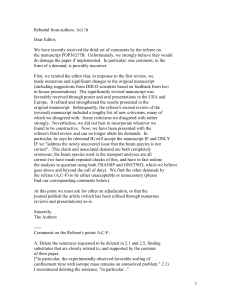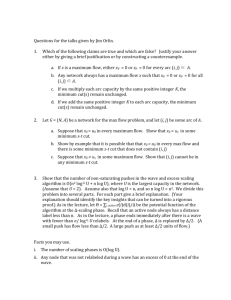TIMP`s Template
advertisement
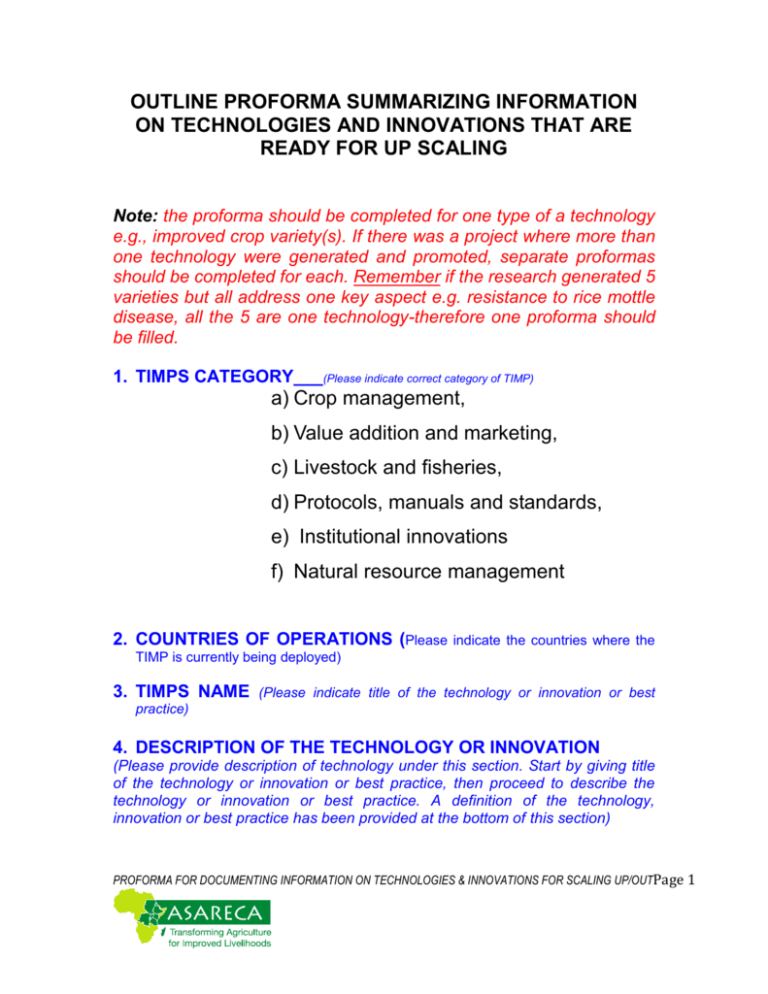
OUTLINE PROFORMA SUMMARIZING INFORMATION ON TECHNOLOGIES AND INNOVATIONS THAT ARE READY FOR UP SCALING Note: the proforma should be completed for one type of a technology e.g., improved crop variety(s). If there was a project where more than one technology were generated and promoted, separate proformas should be completed for each. Remember if the research generated 5 varieties but all address one key aspect e.g. resistance to rice mottle disease, all the 5 are one technology-therefore one proforma should be filled. 1. TIMPS CATEGORY___(Please indicate correct category of TIMP) a) Crop management, b) Value addition and marketing, c) Livestock and fisheries, d) Protocols, manuals and standards, e) Institutional innovations f) Natural resource management 2. COUNTRIES OF OPERATIONS (Please indicate the countries where the TIMP is currently being deployed) 3. TIMPS NAME (Please indicate title of the technology or innovation or best practice) 4. DESCRIPTION OF THE TECHNOLOGY OR INNOVATION (Please provide description of technology under this section. Start by giving title of the technology or innovation or best practice, then proceed to describe the technology or innovation or best practice. A definition of the technology, innovation or best practice has been provided at the bottom of this section) PROFORMA FOR DOCUMENTING INFORMATION ON TECHNOLOGIES & INNOVATIONS FOR SCALING UP/OUT Page 1 Title of the technology or innovation or best practice: - Describe: The technology or innovation being proposed [max 1 ½ page] The problem it aims to address. Describe the technology or innovation-What is it? Justification/(advantage over others) why the technology is appropriate for promotion as best practice for scaling up and out. Where in the sub-region the technology/innovation has been developed and where is it suitable for up scaling/promotion. This refers to the geographic area/country, temperature, relative humidity, rainfall and soil type Evidence that the technology and or innovation works, is ready for use and may have been proven/ validated (or has gone through some form of formal release where relevant). If some adaptation would be required, this can be stated in this section and also be mentioned in the application guideline section. Guiding Notes: Definition of technology and or innovation: Technology is defined as one or a combination of tools; equipment; genetic resources (genetic materials or breeds/varieties); production practices; methodologies/protocols; post-harvest/value addition products & practices; natural resources and biodiversity management practices; crop and animal management/husbandry practices; gathering practices; laboratory techniques and models; marketing practices; and the knowledge and skills needed to use them. Innovation is the use of knowledge (indigenous and exogenous) in a place or by people in a way that it has not been used before. To be called an innovation, it must be replicable at an PROFORMA FOR DOCUMENTING INFORMATION ON TECHNOLOGIES & INNOVATIONS FOR SCALING UP/OUT Page 2 economical cost and must satisfy a specific need. Innovation involves deliberate application of information, imagination, and initiative in deriving greater or different value from resources, and encompasses all processes by which new ideas are generated and converted into useful products. Technologies and innovations ready for up scaling may be any of the following: genetic resources (genetic materials, genes, markers, DNA sequences, breeds of livestock, varieties of crops, collections of crops and their wild relatives), postharvest handling, methodologies, protocols; tool, instrument, implement, utensil, appliance, laboratory techniques, production practices, post-harvest/value addition products & practices, natural resources and biodiversity management practices, crop management practices, animal husbandry practices, gathering practices; equipment, apparatus, gear, materiel, outfit, paraphernalia, models, policies, marketing practices, knowledge and skills. For indigenous technical knowledge (ITK), it would be useful to capture and could fit into any of the thematic field; 5. Assessment/reflection on utilization, dissemination & scaling out or up approaches used (even for new technologies, some form of utilization, dissemination, scaling out or up may have been done and therefore reflection on the approaches used in this case is useful too) [Max 1 page] - Who are the users of the technology/innovation? - What dissemination, scaling out/up approaches were used? - Which of these (approaches) may be most effective and why? - What are the critical and essential factors for successful promotion and adoption of the technology/innovation? PROFORMA FOR DOCUMENTING INFORMATION ON TECHNOLOGIES & INNOVATIONS FOR SCALING UP/OUT Page 3 - In the approach, it would be useful to indicate who (what essential partners/stakeholders) should be involved in the further scaling out/up 6. Current situation and future scaling up [Max 2 pages] - What is the current extent of reach of intended users of technology or innovation? - Give the challenges (if any) encountered in respect to further disseminate the technology/innovation, adoption and scaling up/out - Recommendation for addressing the challenges - lessons learnt about the best ways to get the technology or innovation to reach and be used by the largest number of users - In your view, what are the social, environmental, policy and market conditions necessary to catalyse cross-boarder scaling up of the technology or innovation? 7. Economic considerations [Max 1/2 page] - What are the basic costs (local currency and equivalent US $) associated with application/utilization of the technology or innovation? You may want to consider such costs as purchased inputs, construction or installation) - Estimated returns (local currency and equivalent US$) such as cost benefit or gross margin figures where applicable 8. Gender considerations [Max 1 page] - Who was greatly affected by the problem (men, women youth (f/m) PROFORMA FOR DOCUMENTING INFORMATION ON TECHNOLOGIES & INNOVATIONS FOR SCALING UP/OUT Page 4 - What gender considerations / issues /concerns were addressed in the development and dissemination of the technology or innovation - Which gender issues / concerns are of importance and yet could not be addressed by the technology or innovation? - Who is the main user of this technology (men, women youth (f/m)? - Does the technology have any positive and/or negative effects on the user as an individual or on the household or even on the group / community? Which ones are they? - Is the technology time saving; labor saving; easily accessible; affordable (in terms of resources such as land, capital etc); user friendly (in terms of required skill sets, knowledge, handling etc); durable; highly demanded; and climate smart? If yes/no; how does this affect the adoption and scaling up / out? - Does the technology require advisory support services? - What Gender considerations / issues /concerns are essential and significant in the scale out/up adoption of the technology or innovation and how can they be addressed? - Are there any gender-related challenges and constraints (if any), that hindered or may hinder the promotion and/or adoption and / or scale out/up of the technology? How can they be addressed? - Are there any gender-related opportunities (if any), which enhanced or can enhance the promotion and/or adoption and/or scaling out/ up of the technology. How can these be harnessed? - Are there any projected gender related unplanned effects or risks that the project should take into consideration and devise a mitigation strategy? 9. Case study or profiles of success stories [Max 1 page]. (Optional) - Provide at least one or two success stories from beneficiaries attesting to the ability of the technology or best practice to make a meaningful change (effects such as incomes, food security, livelihoods). PROFORMA FOR DOCUMENTING INFORMATION ON TECHNOLOGIES & INNOVATIONS FOR SCALING UP/OUT Page 5 - Ensure that the profiles provided as case studies are written as success stories and contain appropriate quantifiable information and pictures. 10. Application guidelines for the users (Essential & critical information that will enable extension agents, private sector to read the guideline and apply) [Max 1 page] 11. Contact details (Contact details of the generators/promoters of the technology/innovation; please provide P.O Box, Telephone both landline and mobile where possible and email address). - Name and contact address of the lead organisation and the scientist who lead the generation/promotion of the technology - Name and contact address of other partner organizations and key scientists or non-scientists 12. Additional information (photographs in original JPEG format, maps, charts, dissemination or promotional materials etc.). - This should be provided separately as annexes to the proforma. Glossary of terms provided separately as an annex PROFORMA FOR DOCUMENTING INFORMATION ON TECHNOLOGIES & INNOVATIONS FOR SCALING UP/OUT Page 6
